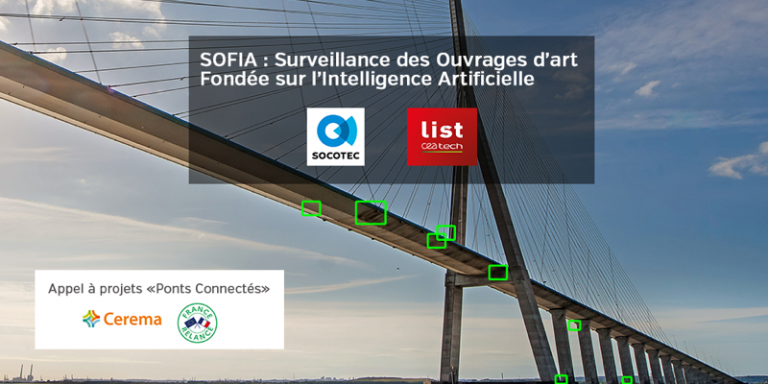
France has many civil infrastructures (bridges, buildings, networks…) subject to aggressive environments, to the ageing of their elements or their constituent materials, to evolutions or to exceptional operating conditions. To assess the state of conservation of engineering structures, visual inspection is the most commonly used method. However, it is a very subjective technique as it relies on the interpretation of the images by the inspectors. These inspection reports are the main source of data for structure managers to optimize maintenance plans. The SOFIA project led by SOCOTEC in partnership with the CEA-List, winner of the CEREMA’s call for “Connected Bridges”projects within the framework of France Relance, aims at a major technological breakthrough in inspection tools thanks to artificial intelligence for vision.
Optimized maintenance is necessary
There are 200,000 bridges in France, whose overall ageing was highlighted in 2019 by the Senate’s Commission on Spatial Planning and Sustainable Development. These structures, which are essential to road traffic, have a limited lifespan (estimated at around 100 years) and their condition must be inspected regularly. A large number of them date from the “Trente Glorieuses” and are now reaching a stage of ageing that requires vigilance. Modest structures are doing well, but there are also reinforced concrete structures from the beginning of the twentieth century that are reaching the end of their service life.
On the other hand, there are still many masonry bridges, some of them very old, in the departmental network. Most of them have undergone more or less extensive repairs over the centuries (the Pont-Neuf in Paris, for example, of which only the arches of the small arm are original).
All the older structures in service have undergone changes since the time of construction
the time of their construction: increased traffic and heavy loads, changes due to
and loads of heavy goods vehicles, changes due to climate change (floods, low water levels),
changes in the structure itself. These changes have an impact on their service life.
Whether they are new or old bridges, the equipment must be
the equipment must be changed during the life of the structure, the cleaning must be done regularly and the
the pavement to ensure that the surfacing continues to perform its role of protecting the structure.
structure. In addition to the risk of collapse, which can cause casualties, there is also the economic and social risk in the event of accidental closure or closure imposed by the condition of the structure: the case of the Morandi bridge in Genoa is unfortunately a very recent example.
The SOFIA project
To meet this challenge, in December 2020, the government launched the “Connected Bridges” call for projects as part of the France Recovery Plan. The call was led by CEREMA, a public institution whose expertise in engineering structures and experience in serving the territories is well established. The aim of this call was to support research centres and companies working on innovative solutions for monitoring and managing structures and to offer them the latest innovations in terms of instrumentation, which are more practical, more efficient and less costly.
Within the framework of this call for projects, SOCOTEC has joined forces with CEA List, which will contribute its expertise in imaging and machine learning techniques, as well as the Jura Departmental Council and SANEF. SOCOTEC relies on a major technological breakthrough in its inspection tools for engineering structures thanks to the contribution of AI.
Their SOFIA project (Surveillance des Ouvrages d’art Fondée sur l’Intelligence Artificielle), led by SOCOTEC, an independent trustworthy third party, specialized in Testing, Inspection and Certification in the Construction and Infrastructure sectors, is therefore a winner of this call for projects.
Innovations of the SOFIA project
Without additional instrumentation or modification of the inspection modes, the CEA-List vision-based detection and fine recognition algorithms will automatically detect and characterize the defects photographed by the inspector on site. Thanks to a learning process based on some 100,000 inspection photographs from SOCOTEC’s image and data bank (extracted from 2,500 inspection reports and characterizing 250 types of defects), SOFIA’s technology will guide the inspector in capturing information and will propose a “status note” for the inspected elements.
Future inspections will allow the AI-based models to become more sophisticated. The ultimate goal is to improve the reliability of condition assessments by producing more consistent inspection reports enriched by the experience of past inspections. The SOFIA project will make the work of inspectors easier, more reliable and faster without changing the way a visual inspection is conducted.
Later, this new functionality will be integrated into SOCOTEC’s inspection tool with a decision support module, to facilitate the synthesis of information and the creation of the inspection report. Its use of AI and vision will identify elements requiring further investigation, refining the accuracy and completeness of inspections compared to current practices.
The use of massive inspection data by AI will also enable predictive maintenance.
Translated from Projet SOFIA : L’intelligence artificielle pour la vision au service de la maintenance des ouvrages d’art









